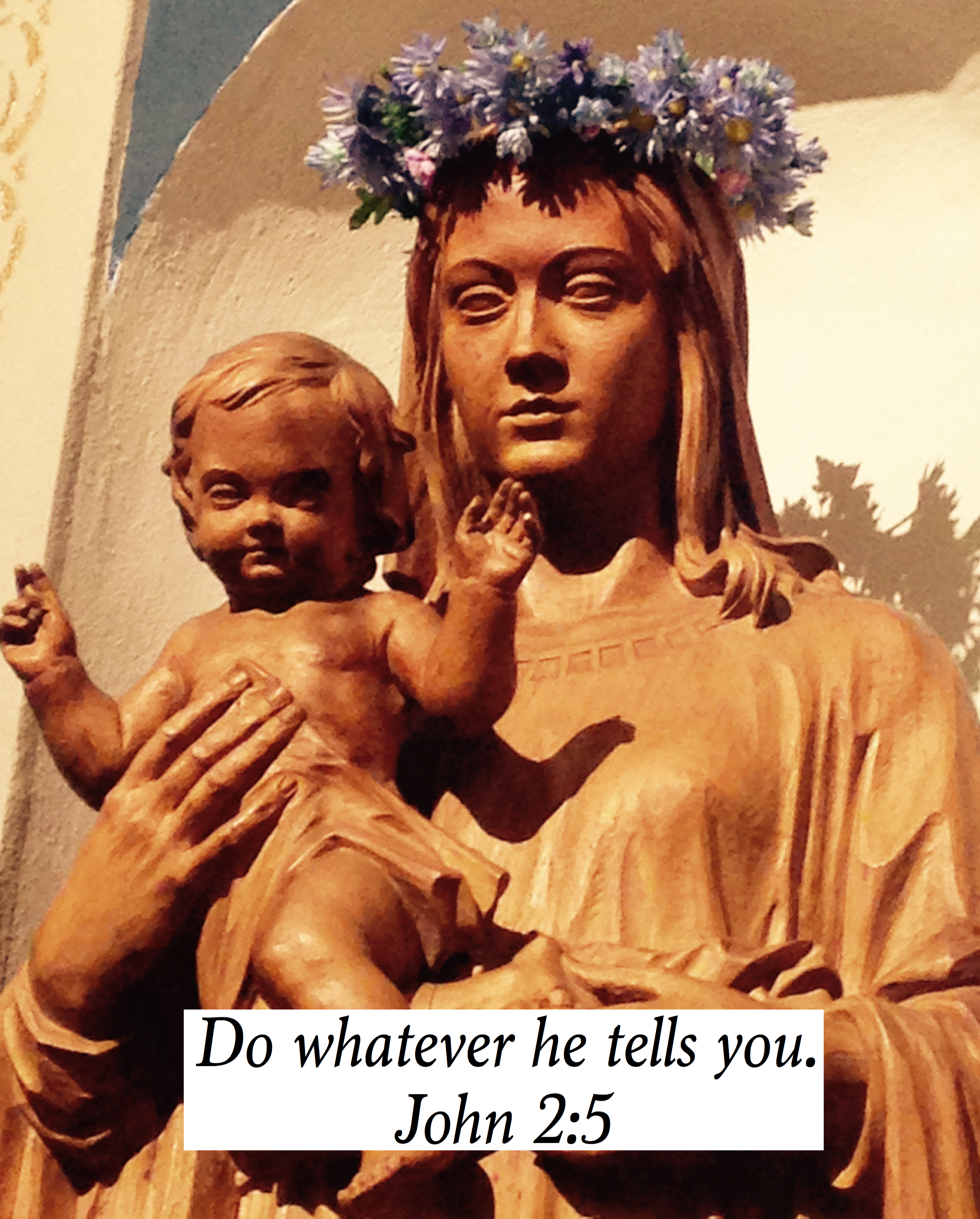As #MeToo campaigns rage and countless men are outed for the sexual harassment, abuse and assault of women, it may be time to look to a woman—THE WOMAN—for the answer on how to heal this mess...
Read moreEverything Old Is New Again: Why the Women's March Was More of the Same Old Stuff
Dear Friends, In honor of today's March for Life in Washington, I offer the below reflection, which is not meant to be polemical or to condemn any one person for their participation in the Women's March last week. It is simply meant to name the spiritual reality that I believe we are dealing with and the spiritual remedy needed. Let us pray for the healing of the wounds of our nation, and all that drives women to seek abortion as a solution to an unexpected pregnancy. Our Lady of Guadalupe, patroness of life, pray for us.
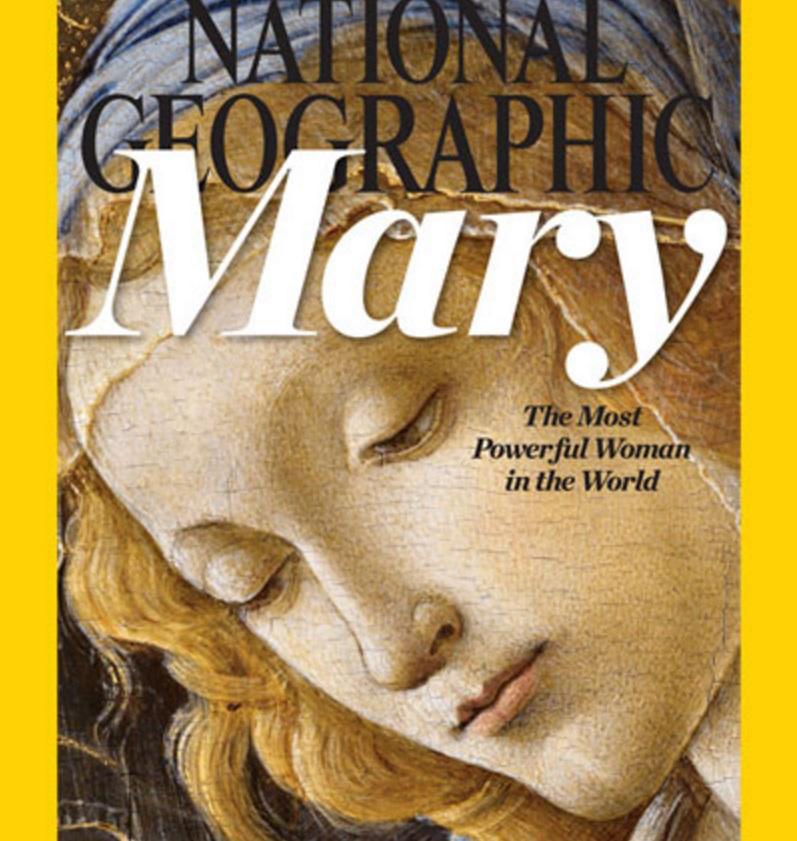
Answer me, Lord! Answer me, that this people may know that you, Lord, are God and that you have brought them back to their senses. 1 Kings 18:37
A quick perusal through the Old Testament story of the Prophet Elijah (1 Kings 16 ff.) and his showdown with the wicked pagan queen, Jezebel, confirms that this week in America, everything old is new again. New again is the sinful human tendency to want absolute power and control, and new again is the willful determination to use aggression, violence and all manner of ungodly means to achieve it.
Case in point: This week’s January 22 anniversary of the infamous Supreme Court decision legalizing abortion in America was preceded on January 21 by the Women’s March on Washington. After watching the coverage all weekend on various new outlets, I could conclude only one thing: the fundamental thing the marchers wanted to protect the state-sanctioned prerogative of killing their children, and they will steamroll anyone who tries to deny them that power. Because, while claiming they were marching for women’s rights, not one protester could actually articulate a right they were marching for which women don’t already possess. What bled through their protest, however, is that they fear losing the right to unrestricted access to abortion on demand under the Trump administration, and that they are willing to engage in a tirade of biblical proportions to make sure that doesn’t happen. Which brings me back to Jezebel.
Jezebel, the wife of Israel’s King Ahab and the power behind his throne, could be called “Eve on crack.” She influenced her husband to both engage in Baal worship and promote it among the Israelites, leading God’s people into apostasy through the practice of deviant sexual rituals, human sacrifice and self-mutilation—all for the purpose of controlling the fertility gods. Sound familiar? Jezebel operated without conscience or scruples to have her way, urging her husband to oppose the worship of the one true God, destroy his altars and kill his prophets, which Ahab promptly did. When Jezebel wanted Naboth’s vineyard, she had Naboth unjustly tried and killed. When Jezebel wanted to silence God’s prophets, she had hundreds of them slaughtered. And when Jezebel’s pagan prophets lost a major power encounter with Elijah on Mount Carmel, she chased Elijah down with all of the vim and vigor of hell to have his throat slit.
Sadly, Jezebel represents the epitome of disordered, fallen femininity: an unapologetically grasping woman who will assert her will and have her way, no matter how much blood is spilled. I couldn’t get her out of my mind as I witnessed the vulgarity and hatred spewing from the mouths, signs and clothing of those at the Women’s March. To my mind, what we witnessed in the Capitol last Saturday was the show of a demonic "spirit" named Jezebel that is the antithesis of spirit of Our Blessed Mother. Such a spirit can only be “tied up” through prayer, fasting and repentance (Mk 3:27, Mt 17:21), all of which we are summoned to by our bishops in response to the stronghold of death in our culture.
The hopeful news is that there’s another march in Washington today, and its protestors will march Mary’s way. They will humbly, prayerfully and respectfully show up in our nation’s capital to make a plea for protection and justice for the unborn. They will sing praise to God, carry banners that are dignified, and meet with legislators politely to plead the case that all human life is sacred and inviolable. They will dress modestly, behave courteously, and demonstrate nobly, seeking to show a confused world that love and humility beget love and humility, and that violence and aggression spawn more of the same. Marching Mary’s way, the protesters may remain unseen and hidden to the world-at-large as the secular news media, power brokers and pundits ignore them. Nonetheless, hundreds of thousands of March for Life protesters will march mightily under the standard of Almighty God for the cause of truth and life.
Mary’s way is never one of self-assertion, domination or control, but is instead the way of generous, unassuming, self-sacrificing love. Her open and welcoming stance toward both God and human life would never be labeled “powerful” according to the world’s criterions, but the Mother of the God-man is the most powerful woman who ever lived. Paradoxically, her power is manifested not through assertion, but instead through her absolute surrender to God and to love. She has much to teach us today about what it means to be women, but we must choose to follow her way.
Let us beg God to place Mary’s mantle of peace and protection over over each and every one of us, and over our nation. May we also ask, as Elisha asked Elijah, for a double portion of Mary’s spirit to fall upon us and upon the women of our land.
This article was previously published at Aleteia.
How The Feminine Genius Can Save The World
The hour is coming, in fact has come, when the vocation of woman is being achieved in its fullness, the hour in which woman acquires in the world an influence, an effect, and a power never hitherto achieved. That is why, at this moment when the whole human race is undergoing so deep a transformation, women impregnated with the spirit of the gospel can do much to aid mankind in not falling. Second Vatican Council, Closing Message to Women
In last week’s post, which quoted Saint John Paul II on the problem of “models of male domination,” I suggested that the prevalence of a deformed prototype of masculinity has gotten us into the political and cultural mess we’re in.
The piece was oddly prophetic in its timing, given the fact that it ran the same morning the story broke exposing Donald Trump’s horrific comments about groping women—confirming in living color how the man shamelessly objectifies women, treating them as “things” to be possessed and violated at his whim.
Three days later Hillary Clinton stood on a debate stage and proudly announced that she will appoint Supreme Court justices that will uphold Roe vs. Wade—affirming once again how she shamelessly objectifies unborn children via her unapologetic stance that a woman should have the right to kill her pre-born child without restriction until a baby is born, treating them as “things” to be disposed of at a woman’s whim.
Again—these behaviors speak of what Saint John Paul II called “models of male domination”—systems of power that blatantly employ exploitation, aggression, and violence to rule over others and to have one’s own way. Obviously, Trump and Clinton didn’t invent this problem, but are instead the perfect representatives of a culture that largely embraces such an approach to reality.
What is the remedy for these disordered attitudes, beliefs and behaviors—attitudes that have spawned what John Paul II termed the “culture of death”? Interestingly, the visionary pope taught that it is the “feminine genius” that can re-humanize and re-civilize the world, and echoing the words of the Second Vatican Council, suggested that “now” is the hour when the genius of women is needed to save a free-falling world:
Unilateral progress can also lead to a gradual loss of sensitivity for man, that is, for what is essentially human. In this sense, our time particularly awaits the manifestation of a “genius” which belongs to women, and which can ensure sensitivity for human beings in every circumstance: because they are human! Pope John Paul II, On The Dignity and Vocation of Women, 30.
Pope John Paul II taught in various documents and ways that “the ‘woman’ is the representative and the archetype of the whole human race: she represents the humanity which belongs to all human beings, both men and women.” (Pope John Paul II, On the Dignity and Vocation of Women, 4) As such, woman stands as the symbolic key to humanity’s return to a right relationship with God and the entire created order—as the key to bringing the culture of death back to its senses.
Why?
Because woman—in the image of the Woman, Mary—incarnates in her very nature the way in which all human beings are purposed to relate to God: that is, standing in the feminine posture of Mary’s fiat mihi proclaiming “Let it be done unto me.” With hands, heart, mind and body surrendered to God, Mary becomes a conduit of life and love, both human and divine, becoming the icon of the sacred call of every human person. Conversely, when hands, hearts, minds and bodies close in on themselves, turn against God and turn instead to their own lordship, human beings become a channel of death for themselves and for others.
When we continue to declare that success in this culture means winning, subverting others, and aggressing anyone whom we choose in order to achieve our own agendas, we fall prey to a disordered masculine approach that inverts self-sacrificial love into domination, control, and flagrant disregard of the human person. On the other hand, when we assume the Marian, feminine posture of active receptivity, saying to God thy will be done, we cooperate with God in opening civilization to his grace, grace that alone can save us and a fallen world.
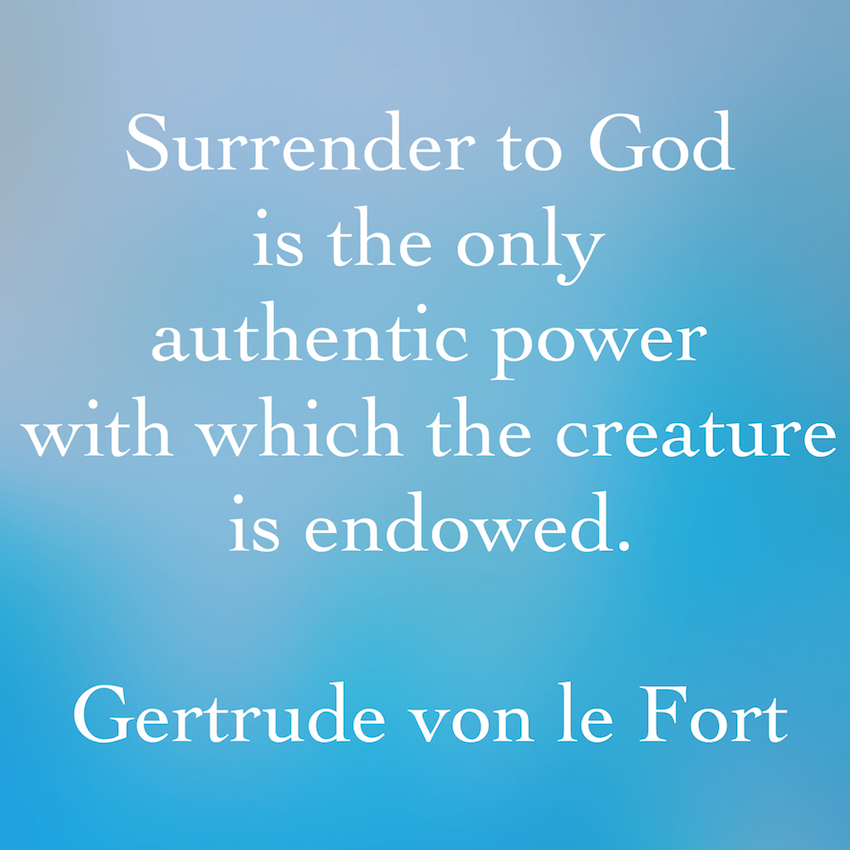
This article was previously published at Aleteia.
On Mary, Jezebel and Suffragettes
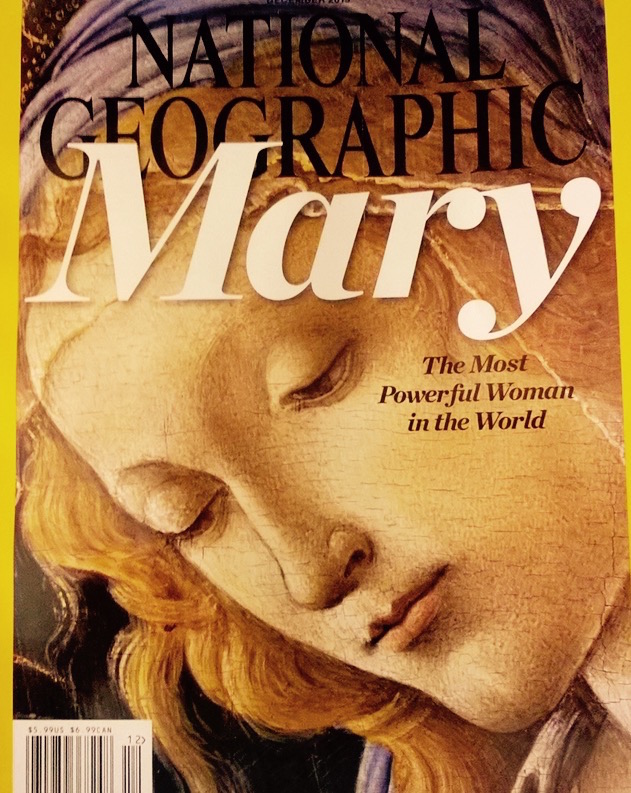 As I watched the excellent movie Suffragette this past weekend, which documents the history of women’s struggle for the right to vote in England, two things really struck me: 1) The women’s rights movement was rightly spawned by the need for women to escape the unjust, dehumanizing and often brutal treatment suffered at the hands of men. 2) It took less than 100 years after gaining the right to vote for women to begin to use the same force, violence and dehumanizing domination they had sought to escape—most tragically, by exerting themselves against their unborn children.
As I watched the excellent movie Suffragette this past weekend, which documents the history of women’s struggle for the right to vote in England, two things really struck me: 1) The women’s rights movement was rightly spawned by the need for women to escape the unjust, dehumanizing and often brutal treatment suffered at the hands of men. 2) It took less than 100 years after gaining the right to vote for women to begin to use the same force, violence and dehumanizing domination they had sought to escape—most tragically, by exerting themselves against their unborn children.
While the movie did not place the struggle for women’s rights into a Christian context, I couldn’t help but think about Saint John Paul II’s words in Mulieris Dignitatem (On the Dignity and Vocation of Women), which I recently reread to prepare for a talk at a women’s conference. More relevant today than when he wrote the Apostolic Exhortation nearly 30 years ago, the great pope wrote forcefully and with striking clarity about the effects of Original Sin, particularly upon women:
“Your desire shall be for your husband, and he shall rule over you” (Gen. 3:16)… Domination takes the place of “being a sincere gift” and therefore living “for” the other…This “domination” indicates the disturbance of and loss of stability of that fundamental equality which the man and woman possess in the “unity of the two”: and this is especially to the disadvantage of the woman. Mulieris Dignitatem, par. 10.
In other words, the fundamental equality God intended between men and women was ruptured through sin; sin that has played itself out historically in disunity between the sexes, most often at the expense of women. As Suffragette accurately depicts, women have fought hard to gain a voice in a world ruled by lopsided patriarchal attitudes and customs, sometimes at the expense of their own lives. Their goal was threefold—the right to vote, the right to education and the right to employment, rights for which women in various areas of the world are still fighting today.
Sadly, the struggle for women’s rights did not stop with authentic human equality, but instead morphed into an all out battle over women’s “reproductive” (read: abortion) rights which rages throughout the world today. It is bitterly ironic that such “rights” demand that women imitate the male models of violence and domination they sought to overcome in the first place. John Paul II warned of the grave danger of such an approach:
Consequently, even the rightful opposition of women to what is expressed in the biblical words, "He shall rule over you" (Gen 3:16) must not under any condition lead to the "masculinization" of women. In the name of liberation from male "domination," women must not appropriate to themselves male characteristics contrary to their own feminine "originality." There is a well-founded fear that if they take this path, women will not “reach fulfillment,” but instead will deform and lose what constitutes their essential richness. Mulieris Dignitatem, par. 10.
And what constitutes the “essential richness” of women? While our feminine giftedness, which John Paul II referred to as “the genius of women,” is deep and multi-faceted, it is grounded in the fundamental orientation that women have toward love and life in virtue of the fact that our hearts, minds and bodies are ordered to motherhood, and hence, naturally toward loving and caring for other persons.
Suffragette left me asking: what went wrong in the fight for women’s rights, which has culminated in millions of women doing violence to the very persons we are called to nurture and protect? My theory is that the bastardization of the authentic movement for the recognition of women’s dignity was hijacked by what I call “the Jezebel spirit,” which is the age-old temptation toward grasping for power wherein women to use manipulation, domination, control and even violence to beat men at their own game.
One of my favorite stories from the Bible is in this week’s Mass readings, where the prophet Elijah engages in a showdown with the prophets of Baal on Mount Carmel during which the reality and power of Israel’s God—the one true God—is ably demonstrated. The backstory of that power encounter reveals that the wicked pagan queen, Jezebel, and her spineless husband, King Ahab, together led the Israelites into apostasy through “the veneration and worship of Baal” (1 Kings 16:31).
Interestingly, Baal worship involved the belief in having sway over the fertility gods, who were supposedly appeased by self-mutilation, deviant sexual practices and child sacrifice. Sound familiar? Jezebel’s “spirit”—in direction opposition to the spirit of Mary, the Mother of God—is all about exercising power for the sake of control: control over men, control over the gods, control over fertility and ultimately, control over life and death. In contrast, Mary’s spirit, which is the icon of both authentic femininity and all true humanity, is all about reigning supreme through the gift of self given to God and others in self-donating love, life-giving generosity and self-sacrificing service.
Mary or Jezebel? Each generation of women must decide whom we will emulate. Indeed, the future of the world depends on our choice—and the choice is in no uncertain terms one between life and death, the blessing or the curse.
The Holy Name of Mary
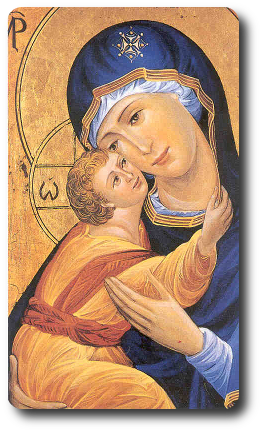 Feast of the Holy Name of Mary
Feast of the Holy Name of Mary
For many years, I have tried to explain to my Protestant friends how and why Catholics love Mary. I came across this exquisite reflection by Thomas Merton this week in his book, "New Seeds of Contemplation." He says it much better than I could ever hope to do, so I share this with you on this special feast of Our Lady. May we all come to resemble Jesus by resembling Mary, whose poverty, hiddenness, and total abandonment to God made her a perfect instrument of His glory.
Blessings and grace to you! Judy
Mary alone, of all the saints, is, in everything, incomparable. She has the sanctity of them all and yet resembles none of them. And still we can talk of being like her. This likeness to her is not only something to desire – it is one human quality most worthy of our desire: but the reason for that is that she, of all creatures, most perfectly recovered the likeness to God that God willed to find, in varying degrees, in us all.
It is necessary, no doubt, to talk about her privileges as if they were something that could be made comprehensible in human language and could be measured by some human standard. It is most fitting to talk about her as a Queen and to act as if you knew what it meant to say she has a throne above all the angels. But this should not make anyone forget that her highest privilege is her poverty and her greatest glory is that she is most hidden, and the source of all her power is that she is as nothing in the presence of Christ, of God.
This is often forgotten by Catholics themselves, and therefore it is not surprising that those who are not Catholic often have a completely wrong conception of Catholic devotion to the Mother of God. They imagine, and sometimes we can understand the reasons for doing so, that Catholics treat the Blessed Virgin as an almost divine being in her own right, as if she had some glory, some power, some majesty of her own that placed her on a level with Christ himself. They regard the Assumption of Mary into heaven as a kind of apotheosis and her Queenship as a strict divinization. Hence her place in the Redemption would seem to be equal to that of her Son. But this is all completely contrary to the true mind of the Catholic Church. It forgets that Mary's chief glory is in her nothingness, in the fact of being “Handmaid of the Lord,” as one who in becoming the Mother of God acted simply in loving submission to His command, in the pure obedience of faith. She is blessed not because of some mythical pseudo-divine prerogative, but in all her human and womanly limitations as one who has believed. It is the faith and fidelity of this humble handmaid, “full of grace” that enables her to be the perfect instrument of God, and nothing else but His instrument. The work that was done in her was purely the work of God. “He that is mighty hath done great things in me.” The glory of Mary is purely and simply the glory of God in her, and she, like anyone else, can say that she has nothing that she has not received from Him through Christ.
As a matter of fact, this is precisely her greatest glory: that having nothing of her own, retaining nothing of a “self” that could glory in anything for her own sake, she placed no obstacle to the mercy of God and in no way resisted His love and His will. Hence she received more from Him than any other saint. He was able to accomplish His will perfectly in her, and His liberty was in no way hindered from its purpose by the presence of an egotistical self in Mary. She was and is in the highest sense a person precisely because, being “immaculate,” she was free from any taint of selfishness that might obscure God's light in her being. She was then a freedom that obeyed Him perfectly and in this obedience found the fulfillment of perfect love…
In all the great mystery of Mary, then, one thing remains most clear: that of herself she is nothing, and that God for our sakes delighted to manifest His glory and His love in her.
It is because she is, of all the saints, the most perfectly poor and the most perfectly hidden, the one who has absolutely nothing whatever that she attempts to possesses as her own, that she can most fully communicate to the rest of us the grace of the infinitely selfless God. And we will most truly possess Him when we have emptied ourselves and become poor and hidden as she is, resembling Him by resembling her...
This absolute emptiness, this poverty, this obscurity holds within it the secret of all joy because it is full of God. To seek this emptiness is true devotion to the Mother of God. To find it is to find her. And to be hidden in its depths is to be full of God as she is full of Him, and to share her mission of bringing Him to all men.
Drinking Mary's Cool Aid
In honor of May, the month of Mary, and in conjunction with my live interview on Dina Marie on KBVM 88.3 in Portland this morning from 10-11 a.m. Central, I am re-posting this blog on Our Lady. I'll be discussing Mary and Motherhood, so please join us at http://tunein.com/radio/Catholic-Radio-883-s31902/. God bless!
Susan thought her Catholic friends had drunk the proverbial “Kool-Aid.” A staunch evangelical Christian, she was offended and angry after attending my sister-in-law Hedy’s Medjugorje Rosary group and witnessing what she considered to be “blasphemous” prayers being said to Mary. As Hedy continued to host Rosary groups, Susan felt obliged by conscience to end their friendship, convinced that Hedy was not only in idolatry, but was leading others astray through her devotion to Mary.
Susan and Hedy had become friends several years earlier through their children, as each had several kids attending the same school in the small Gulf Coast town of Pass Christian, Mississippi. The two families had grown very close—even taking family vacations together. But their friendship hit a breaking point when Susan and Hedy both became more fervent in their respective faiths, causing Susan to take a stand against Hedy’s perceived “idolatry”—a stand that left the friends and their families estranged for five years.
Eventually, Susan hit a personal faith crisis wherein she recognized that she could “talk the talk” of Christianity, but was unable to “walk the walk” toward the personal holiness she desired. After seriously reflecting upon the people that she knew who truly “walked the walk” as Christians, Susan came to the humbling conclusion that it was the Catholic women she had encountered along the way who had unequivocally treated her with kindness, patience, love and mercy. Though she still questioned their theology, she simply could not deny the fruit their lives bore.
“How could their lives be so full of the fruits of the Holy Spirit,” she asked herself, “when their faith is so theologically compromised?” That question led her to a massive interior dilemma about the authenticity of the Catholic faith, which she felt simultaneously drawn to and terrified by. After much prayer and wrestling with God, Susan made a decision not to be led by fear. She returned to the Catholic Church, through which she had made a brief foray a few years earlier when she was confirmed Catholic upon her marriage into a large, Catholic family. (Susan was baptized Episcopal and raised as “nothing,” and her husband had ultimately followed her into Protestantism.)
Susan began to attend Mass and pray the Rosary, while going to the people she had accused of “idolatry” to apologize to them. Surprising even herself, she developed a great love for the Catholic faith, spending the next few years making beautiful handmade Rosaries “in reparation for my blasphemies against the Blessed Mother,” as she tells it.
Fast forward to 2014, when Susan called to ask me where she could buy copies of my book, Miracle Man (which happens to be very Marian, by the way. I, too, had wrestled with Hedy about her devotion to Mary at the same time as Susan—a story I tell in detail in the book. Let’s just say Hedy and the Blessed Mother won.) After meeting me on St. Charles Avenue in New Orleans to buy six copies of Miracle Man, Susan gave the book to her anti-Catholic sister Elizabeth. None of us could have guessed what would happen next.
Elizabeth’s first reaction was severe annoyance at the book’s Catholic overtones and references to Mary, which she found offensive and irritating. But she pressed on to the finish, wanting to know how the story ends. By the time she closed the book, Elizabeth was weeping profusely, and she couldn’t stop crying. She went to bed perplexed, wondering why she had been so profoundly affected by the story.
During the night, she dreamt about “the most beautiful Lady” she had ever seen, who was surrounded by light and filled with a depth of love that Elizabeth had never before encountered. Elizabeth began to follow her, recognizing the Lady as the Blessed Mother. When she awoke, it was clear to her for the first time in her life why Catholics love Our Lady so much, and why she is placed in such high esteem. That story to be continued.
I can happily say that I have indeed drunk deeply of Mary, and oh, how sweet it’s been. She has led me into the heart of the fruit of her womb, Jesus. And He has led me into the heart of the fruit of His sacrifice on the Cross, the Eucharist. Food and drink like I’ve never tasted; the Bread of Angels, the Cup of Eternal Life. I’ll drink that cool, sweet aid any day.
A Catholic Girl's Litany of Humility
This was too good not to share! Enjoy this guest blog by my daughter, Kara Klein. Happy Easter!

Oh, to be female, single and Catholic! A state of great ambivalence (or may we say, distress!) for all too many in today’s world. With the feminine desire to make a gift of herself through marriage in a society where people flee commitment, and with deep longings to bring forth life amidst a culture of death, the future for the devout Catholic female can sometimes look a little grim. While the problem of prolonged singlehood is deep, multi-faceted, and cannot be blamed on (nor solved with) one sex, race, or generation, what do we single Catholic women do while we wait for the desire of our hearts?
Like Mary, we say “yes” with a whole heart to Jesus Christ, who is Love itself, hope with joyful expectation, and learn to love right where we are.
We long for love, but sometimes we’re more focused on being the recipients. We want to be pursued, romanced, courted and carried off into the sunset—which is only natural, as it’s how God made us. But as women, we are called not only to receive love, but also to give it freely. Even now as we wait.
Perhaps this time of waiting for so many is a time of purification, as God refashions our hearts to seek to love rather than seeking to be loved by those around us. We need women today in our world who are willing to love sacrificially without counting the cost—for the sake of the other, and not for what that person gives them.
Can we young singles lay down the desire to be on pedestal for the desire to serve? Can we dare to put others before us? Dare to put Christ first? Dare to be content right where we are, to embrace our lives with gratitude as they are today, trusting that we are in God’s will? Can we dare to be humble?
My roommates and I recently wondered what a Catholic single girl’s Litany of Humility would look like. We came up with this:
From the desire of being stared at…
From the desire of being called, messaged, emailed, tweeted, Facebook stalked or Instagramed…
From the desire of being told I’m gorgeous…
From the desire of hearing there isn’t, never was, and never will be anyone else quite like me…
From the desire of a four-carat diamond ring…
Deliver me, Jesus.
From the fear of being alone…
From the fear forever being a bridesmaid…
From the fear of gaining 5 more pounds…
From the fear of my ticking biological clock…
From the fear of the single life being my permanent vocation…
Deliver me, Jesus.
That others be pursued more than I…
That others get asked out more than I…
That others get married before I do…
That others have children even when I don’t…
That others be happier than I, provided that I become as happy I should…
Jesus, grant me the grace to desire it.
Jesus, meek and humble of heart, unafraid to be single till the day you died, hear us.
It hurts to stop looking for the love we long to have, to stop demanding love, and instead, search every day for ways we can offer it to the world around us. But as a priest once told me, “In becoming a woman, you must be the one to love, to serve, to give, and you will find the joy you are looking for.”
Birthing Grace
I wish I could have captured that moment in time. Forever. It was silent, sacred, sacramental.
I stood at the bedside of my daughter, Gaby, on Holy Saturday morning as she prepared to give birth. The room was cool and dimly lit, filled to the brim with the anticipation of new life. As I closed my eyes to pray for a safe delivery between Gaby’s instructed pushes, I entered into the sacrosanct silence of the room; the quiet hush of awe and reverence that comes in waiting for a child to be born.
Only one sound pierced the stillness—the steady beat of the baby’s heartbeat registering on the monitor rhythmically: thump, thump, thump.
Standing with my eyes shut tight, listening attentively to the baby’s heartbeat, I sensed the heart of Jesus pulsating with love for the world. Thump, thump, thump, I heard the God-man’s heart ringing out. I thought about the meaning of Holy Saturday—a day of anticipation, a time of looming rebirth, a period of waiting for the full bloom of love to burst forth from God’s heart, the same heart that had been silenced on Good Friday. It was a fitting day for Rose Grayson to be born.
Rose’s annunciation came the week before her father learned he had cancer, ushering in what would become a “Triduum” kind of year. A young family discovering they were pregnant and facing the reality of human mortality in one sweeping breath, moving from happy excitement to fear and grief, embracing the mysteries of life and death all at once. The hopeful expectation of a new baby, made present alongside the agony of not knowing the outcome of a cancer diagnosis. Baby readying, and the accompanying labor of cancer testing, surgeries, and waiting for results. The paradox of the cross, presented with penetrating clarity.
Then came the final prognosis: cancer free! And the ultrasound news: a girl, the first to join three brothers! I watched the little family move out of Good Friday as healing rays came and life resumed its course with renewed vigor and purpose. And now it was Holy Saturday, the day of Rose Grayson’s birth.
The womb is not unlike Jesus’ tomb, I pondered, waiting to see Rose’s tiny face. In a place of dark silence, an enclosed border establishes a clear boundary with the world, and life secretly does its bidding until the darkness is overcome with a burst of brilliant light. Suffering offered and labor pains become cries of joy: He is Risen! It’s a girl!
In the silent enclosure of a birthing room, I gave thanks to God. Grace has ushered in a resurrection. God has given us “Rosie Grace.”
Your death, Lord Jesus, is our life . Your grave the womb of radiant light.
Hymn for Holy Saturday Evening, The Vigil of The Resurrection
Catching the Faith
Please enjoy this re-post of my last Easter blog. This Easter, I was busy welcoming my new granddaughter, Rose Grayson, to our family. She is blessed to have three big brothers and her parents, Gaby and Grayson, to pass the faith to her. Happy Easter!
“Christos Anesti ek nekron, thanato thanaton patisas, kai tis en tis mnimasi zoin harisamenos,” my little grandsons chanted in unison as I watched happily in surprised silence. “Christ is risen from the dead, trampling down death by death, and to those in the tombs, granting life,” the boys rang out in Greek, singing the ancient paschal troparion taught to them by my son-in-law, Grayson. Five-year-old James looked entranced, while two-year-old John-Henry danced around the room, slapping his hips and throwing his hands into the air to provide dramatic effect at just the right moments. Even baby Joseph, who just turned one, chimed in.
“Catholicism is caught, not taught,” I thought as I observed the children singing, remembering the familiar adage from Catholic theology that I’ve quoted numerous times to my students. “We don’t sit a one-week-old infant down and tell him everything he’ll ever need to know about the Catholic faith,” I’ve explained repeatedly when teaching how the truths of our faith are passed down in tact from one generation to the next. Instead, we start with songs, pictures and simple blessings. We take the kids to Mass, point out statues and stained glass windows, and maybe light a candle for those we love. We read Bible stories, whisper prayers in the dark when bad dreams invade the night, and sing—in Greek if we so desire—the deep mysteries of our faith, learned on an I-phone while riding in the van. That’s how our children catch the faith, and it’s how we, in turn, catch it back from them.
Catholicism has been “caught” for two thousand years the very same way; that is, through the habits of a living Church that hands on its living faith via time-honored practices that grow organically and culturally throughout history. We call these practices “traditions,” and they are meant to embody and express Sacred Tradition--which is the Truth that Jesus deposited into the Church through His life, death and resurrection, and through the relationships and institutions He established.
The concept of living faith comes down to us from our Jewish ancestors, and was embraced by the Christian Church:
“Take to heart these words which I command you today. Keep repeating them to your children. Recite them when you are at home and when you are away, when you lie down and when you get up. Bind them on your arm as a sign and let them be as a pendant on your forehead. Write them on the doorposts of your houses and on your gates” (Deuteronomy 6:4-9).
In other words, we are to let our faith in God permeate everything we think and say and do. Which doesn’t mean that we’re on our knees 24/7, or that we escape our broken human condition. It does mean, however, that we invite God into all things, and that we remember that He is with us at all times.
Part of the crisis we are facing in our Christian culture is the direct result of the dichotomy that exists between faith and life, due in large part to a modern world that compartmentalizes and hyper-specializes every aspect of life. Our lives have become neatly divided into measurable functions and categories, reducing the expression of Christian faith to a perfunctory Sunday visit. But it is not meant to be so. Our fathers in faith reminded us that the “split between the faith which many profess and (our) daily lives deserves to be counted among the more serious errors of our age.”* Further, they teach us that harmony should exist between our faith in Christ and all of our earthly activities.
I heard that harmony Monday night in the voices of little children, as they chanted, “Christ is risen from the dead” during a family vacation. Yes indeed, they are catching the faith. And they’re throwing it back to me.
*Par. 43, Pastoral Constitution on the Church in the Modern World, Second Vatican Council
The Woman Of My Dreams
by Kara Klein
What a joy and delight to hear the amazing testimony of my daughter, Kara Klein, at the Magnificat Breakfast this week. Truly, the Lord has done great things for her, and holy is His name. Enjoy her guest blog!
Recently at the national Focus conference I heard gifted speaker Sara Swafford tell a group of single young women: “Become the woman of your dreams and you’ll attract the man of your dreams.” This struck a deep chord in me.
As we enter into a new year, and resolutions fill conversations and various forms of media, I’ve been asking myself:
“What do I want for this new year? Not merely, what do I want to do, but who do I want to become? Who is the woman of my dreams?”
Initially, what comes to my mind is: perfection. I want to be perfect, of course. Virtuous and valiant, strong yet sweet, to always do the right thing, say the right thing, know the right thing, to be successful in all I attempt, to love without faltering.
Yet I once heard the very wise Fr. Jacques Philippe say: “More than God wants our perfection, more than he wants our success, He just wants our trust.”
What kind of woman would I be if I didn’t so much grasp after being perfect as much as I trusted in God with my whole heart? If my whole presence exuded the reality: “All is well. We have a Father. He is real, and He is good. We can trust Him with our entire being, abandon ourselves to Him without reserve. And no matter what happens—though the mountains crumble around us and the earth melt like wax before us—we are in His loving hands, and He is working all things for our good.”
Probably I would be less like Eve, and more like Mary. Less like the one who took matters into her own hands out of fear that her Maker was holding out on her, and more like the one who said, “the Lord has done great things for me and holy is His name!”
I think we Christians complicate our lives more than we realize. We think we have to do so much, be so much, achieve so much, discover so much; when all we really have to do is say “yes.” A simple “Let it be done unto me according to your will. Today.
Yes to loving the person that is right in front of us; yes to accepting with peace life as it unfolds before us; yes to trusting radically like a little child. Simple, but not easy.
To be a woman whose trust and joy are not based upon the ever-changing circumstances around her, but solely in a God who loves her. That is a woman of faith. And that is the woman of my dreams.




